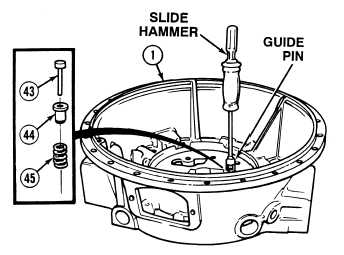|
| |
TM 9-2320-364-34-4
23-55
(32)
With the aid of an assistant, position torque
converter housing (1) with engine mounting
surface facing upward.
(33)
Position valve pin guide remover on valve
pin (43).
(34)
Using valve pin guide remover and slide
hammer, remove and discard lube valve pin
(43), lube valve (44) and lube valve spring
(45) from torque converter housing (1).
c.
Cleaning/Inspection.
Drycleaning Solvent (P-D-680) is TOXIC and flammable. Wear protective goggles, face
shield, and gloves; use only in a well-ventilated area; avoid contact with skin, eyes, and
clothes, and do not breathe vapors. Keep away from heat or flame. Never smoke when
using solvent. The flashpoint for Type II Drycleaning Solvent is 140 degrees F (60 degrees
C) and Type III Drycleaning Solvent is 200 degrees F (93 degrees C). Failure to do so may
result in injury or death to personnel.
If personnel become dizzy while using cleaning solvent, immediately get fresh air and
medical help. If solvent contacts skin or clothes, flush with cold water. If solvent contacts
eyes, immediately flush eyes with water and get immediate medical attention.
(1)
Clean all metal parts with drycleaning solvent.
Compressed air used for cleaning purposes will not exceed 30 psi (207 kPa). Use only with
effective chip guarding and personal protective equipment (goggles/shield, gloves, etc).
Failure to comply may result in injury or death to personnel.
(2)
Dry all metal parts, except bearings, with compressed air. Allow bearings to air dry.
(3)
Inspect bearings for pitting or scoring.
(4)
Inspect retaining rings for nicks, distortion or excessive wear.
(5)
Inspect bearings inside two driven gears for pitting or scoring. If bearings are damaged, replace gears.
(6)
Replace any damaged parts.
|

